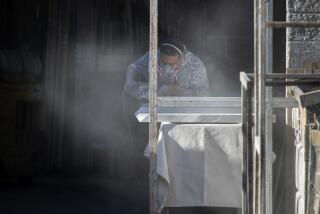Formaldehyde Exposure Levels Cut : OSHA, Facing Contempt Action, Sharply Reduces Limits
- Share via
Threatened with a federal contempt of court action, the Occupational Safety and Health Administration Friday announced that it was dramatically lowering the amount of formaldehyde to which workers may be exposed.
Because formaldehyde causes cancer and other occupational illnesses, the change will benefit more than 2.1 million workers, the agency said.
But several union health and safety officials said that the change, although beneficial, does not go far enough. They specifically asserted that the rules would not benefit 824,000 apparel workers who are exposed to formaldehyde.
Exposure Cut 66%
OSHA, a unit of the U.S. Department of Labor, said permissible worker exposure to formaldehyde would be lowered by two-thirds in a new rule that will be published early next month.
“Health studies indicate that workers exposed to formaldehyde are at increased risk of contracting occupational illnesses,” said John A. Pendergrass, assistant secretary of labor in charge of OSHA. “Our new standard will eliminate significant risks of these diseases among workers through its sharp reduction of permissible exposure levels and through its provisions for medical surveillance, personal protective equipment, housekeeping, exposure monitoring and training,” Pendergrass added.
About 5.7 billion pounds of formaldehyde, a major industrial chemical, are produced annually. The chemical is used in funeral homes for embalming bodies, in medical and pathology laboratories, by foundry workers, by manufacturers of pressed wood products and by about 500,000 apparel workers in the manufacture of permanent-press clothing.
New Standards
The new standard lowers the exposure level at all work sites to one part of formaldehyde per million parts of air, averaged over an eight-hour day, down from the current level of three parts per million. In addition, the rule establishes a short-term exposure limit of two parts of formaldehyde per million parts of air during any 15-minute period.
Adopts ‘Action Level’
In addition, OSHA adopted an “action level” of 0.5 of a part per million during an eight-hour period. Employers whose workers are exposed to that much formaldehyde are required to monitor employee exposure, initiate training programs and provide protective equipment.
For the 13,180 workers currently exposed to more than 1 part of formaldehyde per million parts of air, compliance with the new standard will reduce the number of formaldehyde-induced cancer cases by up to 48 over the next 45 years, according to OSHA spokesman Akio Konoshima. Additionally, he said, OSHA expects that about 6,000 cases of respiratory irritation and 11,000 cases of dermatitis will be avoided annually, with savings of $5.7 million and $35.5 million annually.
John Murray, president of the Formaldehyde Institute, a Washington-based trade organization, issued a statement saying that the new standard would “provide more than adequate protection for workers exposed to formaldehyde-based products. In fact, some of the new technologies for controlling formaldehyde exposures have already substantially reduced human exposures to the compound.”
Criticism From Labor
But several labor spokesmen said that OSHA’s action does not go far enough. “It’s a step forward but it leaves a lot of workers out,” said Margaret Seminario, associate director of the AFL-CIO’s division of health, safety and social security.
Owen Bieber, president of the United Auto Workers, a union that played a major role in pushing OSHA to adopt a stricter standard, called Friday’s announcement “a real but only partial victory.”
The UAW, 14 other unions and the American Public Health Assn. petitioned OSHA for a tougher standard in 1981 and subsequently sued in federal court after the agency failed to act. A federal judge in Washington said last month that he would entertain a contempt action by the plaintiffs if OSHA did not act by today.
Eric Frumin, director of safety and health for the Amalgamated Clothing and Textile Workers Union, was even more critical. He said the overwhelming number of apparel workers exposed to formaldehyde would not benefit from the new standards because the “action level” had been set too high and thus most of them would not automatically be eligible for medical surveillance or further training.
OSHA said that the exposure of 824,000 of the 941,000 apparel workers is below the “action level” of 0.5 of a part per million.
Frumin noted that an Environmental Protection Agency study released in April said that 3 of every 10,000 apparel workers were at risk of getting cancer at current levels of exposure. Frumin and Frank Mirer, director of occupational safety and health for the United Auto Workers, said that their unions would undertake further litigation to tighten the standards and offer workers greater protection.
Staff writer David Lauter in Washington contributed to this story.
More to Read
Sign up for Essential California
The most important California stories and recommendations in your inbox every morning.
You may occasionally receive promotional content from the Los Angeles Times.










